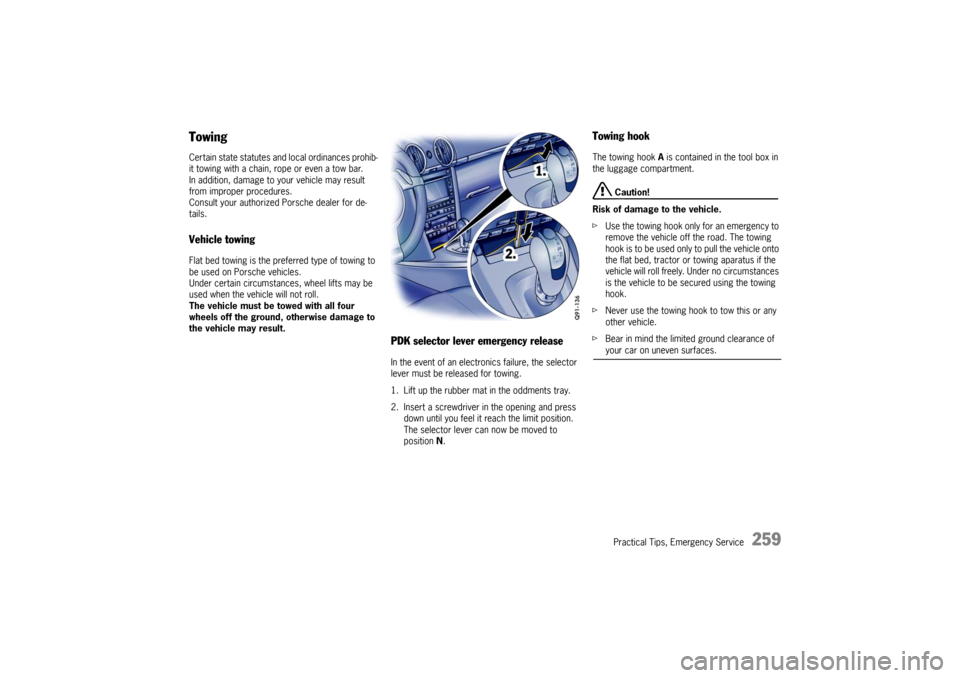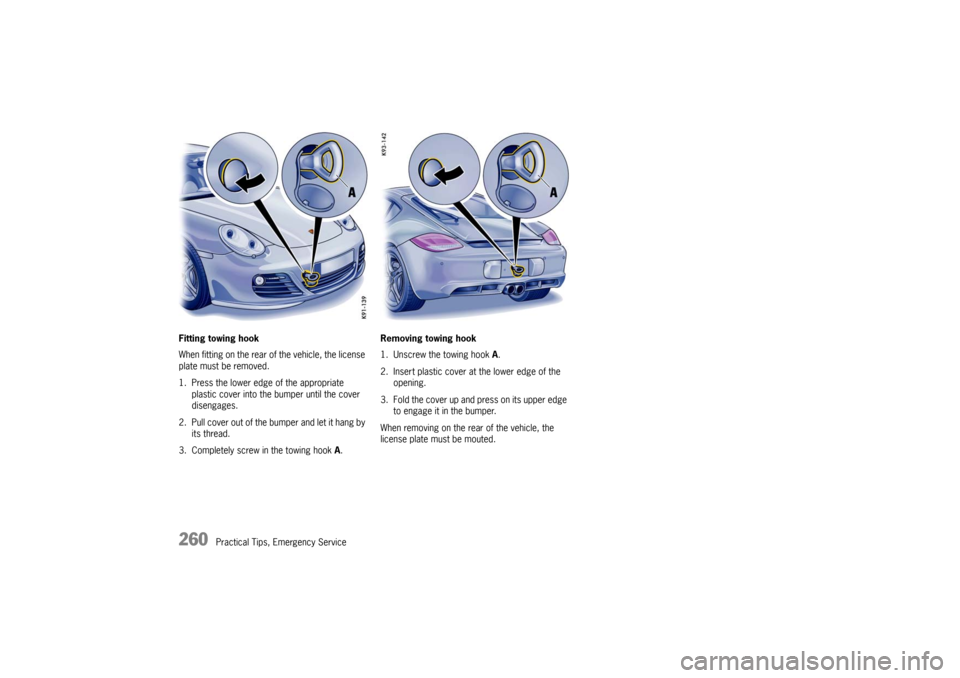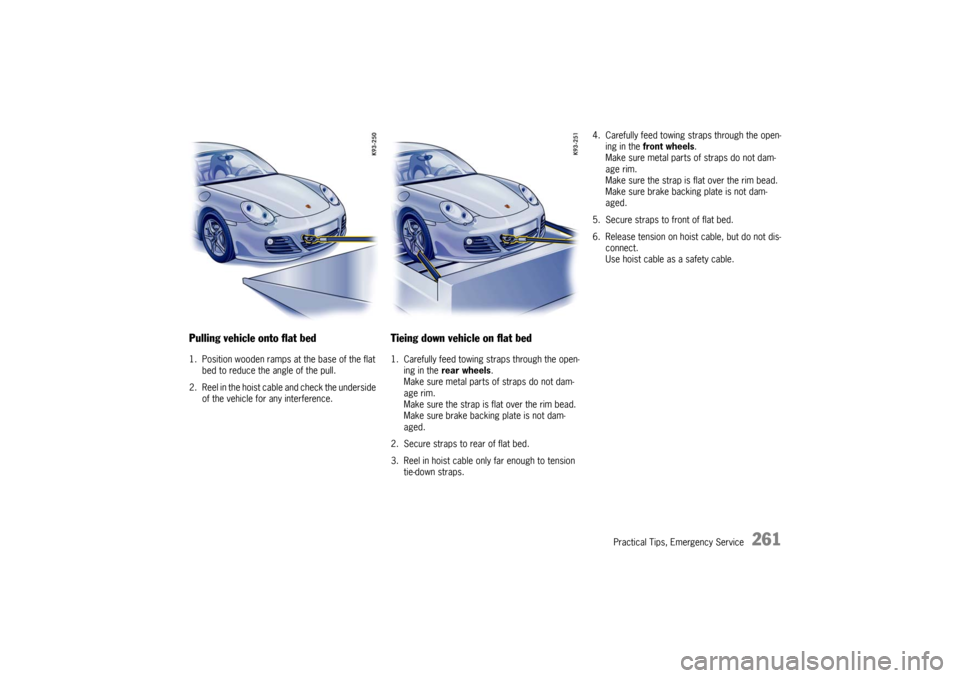PORSCHE CAYMAN 2010 1.G Owners Manual
Manufacturer: PORSCHE, Model Year: 2010, Model line: CAYMAN, Model: PORSCHE CAYMAN 2010 1.GPages: 284, PDF Size: 5.94 MB
Page 261 of 284

Practical Tips, Emergency Service
259
TowingCertain state statutes and local ordinances prohib-
it towing with a chain, rope or even a tow bar.
In addition, damage to your vehicle may result
from improper procedures.
Consult your authorized Porsche dealer for de-
tails. Vehicle towing Flat bed towing is the preferred type of towing to
be used on Porsche vehicles.
Under certain circumstances, wheel lifts may be
used when the vehicle will not roll.
The vehicle must be towed with all four
wheels off the ground, otherwise damage to
the vehicle may result.
PDK selector lever emergency releaseIn the event of an electronics failure, the selector
lever must be released for towing.
1. Lift up the rubber mat in the oddments tray.
2. Insert a screwdriver in the opening and press down until you feel it reach the limit position.
The selector lever ca n now be moved to
position N .
Towing hook The towing hook A is contained in the tool box in
the luggage compartment.
Caution!
Risk of damage to the vehicle.
f Use the towing hook only for an emergency to
remove the vehicle off the road. The towing
hook is to be used only to pull the vehicle onto
the flat bed, tractor or towing aparatus if the
vehicle will roll freely. Under no circumstances
is the vehicle to be secured using the towing
hook.
f Never use the towing hook to tow this or any
other vehicle.
f Bear in mind the limited ground clearance of your car on uneven surfaces.
Page 262 of 284

260
Practical Tips, Emergency Service
Fitting towing hook
When fitting on the rear of the vehicle, the license
plate must be removed.
1. Press the lower edge of the appropriate
plastic cover into the bumper until the cover
disengages.
2. Pull cover out of the bumper and let it hang by its thread.
3. Completely screw in the towing hook A. Removing towing hook
1. Unscrew the towing hook
A.
2. Insert plastic cover at the lower edge of the opening.
3. Fold the cover up and press on its upper edge to engage it in the bumper.
When removing on the rear of the vehicle, the
license plate must be mouted.
Page 263 of 284

Practical Tips, Emergency Service
261
Pulling vehicle onto flat bed 1. Position wooden ramps at the base of the flat bed to reduce the angle of the pull.
2. Reel in the hoist cable and check the underside of the vehicle for any interference.
Tieing down vehicle on flat bed 1. Carefully feed towing straps through the open-ing in the rear wheels .
Make sure metal parts of straps do not dam-
age rim.
Make sure the strap is flat over the rim bead.
Make sure brake backing plate is not dam-
aged.
2. Secure straps to rear of flat bed.
3. Reel in hoist cable only far enough to tension
tie-down straps. 4. Carefully feed towing
straps through the open-
ing in the front wheels .
Make sure metal parts of straps do not dam-
age rim.
Make sure the strap is flat over the rim bead.
Make sure brake backing plate is not dam-
aged.
5. Secure straps to front of flat bed.
6. Release tension on hoist cable, but do not dis- connect.
Use hoist cable as a safety cable.
Page 264 of 284

262
Practical Tips, Emergency Service
Page 265 of 284

Vehicle Identification, Technical Data
263
Vehicle Identification, Technical Data
Vehicle Identification
.................................. 264
Technical Data ....... ................................... 266
Tire Pressure for Cold Tires ...................... 267
Tires, Rims, Tracks .................................. 268
Driving Performance .................................. 270
Capacities ............. ................................... 271
Weights ..................... .............................. 272
Dimensions ........... ................................... 272
Diagrams ................... .............................. 273
Page 266 of 284

264
Vehicle Identification, Technical Data
Vehicle IdentificationWhen ordering spare parts or making inquiries,
please always quote the vehicle identification
number. Vehicle data bankThe vehicle data bank is attached to the inside of
the “Maintenance” booklet.
It contains all important data about your vehicle.
Note
This data bank cannot be re -ordered if it is lost or
damaged.
This label contains the following information:
1. Vehicle Identification No.
2. Type/Type description
3. Engine code/Transmission code
4. Paint No./Interior
5. Optional equipment
Vehicle identification number In accordance with Federal Safety Regulations,
the vehicle identification number of your car is lo-
cated at the bottom left of the windshield frame
and can be seen from the outside.
The vehicle identification number is in the luggage
compartment under the battery cover and at the
bottom left behind the windshield.
Removing the battery cover
f Please see the chapter “BATTERY” on
Page 239.
Safety compliance stickerThe safety compliance sticker is your assurance
that your new Porsche complies with all applicable
Federal Motor Vehicle Safety Standards which
were in effect at the time the vehicle was manufac-
tured.
fThe sticker also shows the month and year of
production and the vehicle identification
number of your car (perforations) as well as
the Gross Vehicle Weight Rating and the G ross
A xle Weight Rating.
Page 267 of 284

Vehicle Identification, Technical Data
265
Tire pressure plateThe tire pressure plate is attached to the left-hand
door aperture.
Engine number The engine number is stamped on the underside
of the crankcase.
Page 268 of 284

266
Technical Data
Technical DataEngine data
CaymanCayman S
Type MA120C MA121C
Horizontally opposed engine, liquid cooled Horizontally opposed engine, liquid cooled
Number of cylinders 6 6
Bore 3.5 in./89 mm 3.8 in./97 mm
Stroke 3.1 in./77.5 mm 3.1 in./77.5 mm
Cubic capacity 176.5 cu. in./2893 cm
3 209.7 cu. in./3436 cm
3
Net-horsepower 265 hp/195 kW 320 hp/235 kW
at crankshaft speed 7200 rpm 7200 rpm
Net torque 221 ft. lb./300 Nm 273 ft. lb./370 Nm
at crankshaft speed 4400 - 6000 rpm 4750 rpm
Engine oil consumption up to 1.6 quarts/622 miles (1.5 liters/1000 km) up to 1.6 quarts/622 m iles (1.5 liters/1000 km)
Page 269 of 284

Technical Data
267
Tire Pressure for Cold Tires (68 °F/ 20 °C)fThese tire pressures apply only to the ti re makes and types approved by Porsche.
Please see the chapter “ WHEEL BOLTS” on Page 226.
f Please see the chapter “TPM TIRE PRESSURE MONITORING” on Page 151.
Summer and snow tires Cayman, Cayman S
17 inch wheels front30 psi (2.0 bar)
rear 31 psi (2.1 bar)
18 inch wheels front30 psi (2.0 bar)
rear 31 psi (2.1 bar)
19 inch wheels front 32 psi (2.2 bar)
rear 34 psi (2.3 bar)
Page 270 of 284

268
Technical Data
Tires, Rims, Tracks CaymanTiresRim Rim offset Track
Summer tires front205/55 ZR 17 91Y 7 J x 17 H2 55 mm 58.7 in./1490 mm
rear 235/50 ZR 17 96Y 8.5 J x 17 H2 40 mm 60.4 in./1534 mm
or front 235/40 ZR 18 91Y 8 J x 18 H2 57 mm 58.5 in./1486 mm
rear 265/40 ZR 18 101Y XL 9 J x 18 H2 43 mm 60.2 in./1528 mm
or front 235/35 ZR 19 87Y 8 J x 19 H2 57 mm 58.5 in./1486 mm
rear 265/35 ZR 19 94Y 9.5 J x 19 H2 46 mm 59.9 in./1522 mm
or front 235/35 ZR 19 87Y 8.5 J x 19 H2 55 mm 58.7 in./1490 mm
rear 265/35 ZR 19 94Y 10 J x 19 H2 42 mm 60.2 in./1530 mm
Snow tires front205/55 R 17 91V M+S 7 J x 17 H2 55 mm 58.7 in./1490 mm
rear * 235/50 R 17 96V M+S 8.5 J x 17 H2 40 mm 60.4 in./1534 mm
or front 235/40 R 18 91V M+S 8 J x 18 H2 57 mm 58.5 in./1486 mm
rear * 255/40 R 18 95V M+S 9 J x 18 H2 43 mm 60.2 in./1528 mm
The load capacity coefficient (e.g. ”91“) and maximum speed code letter (e.g. ”V“) are minimum requirements.